By Doug Hollberg
Just picture thousands upon thousands of .30 M1Garand and ’03 Springfield rifles on racks, carts and boxes waiting to be purchased by qualified shooters and collectors of our country. Unbelievable as it sounds in this age of political correctness, Congress has made this vision reality at the Civilian Marksmanship Program in Anniston, Alabama.
These rifles defended this country and our allies for over half a century. The Doughboy returning from World War I was no longer satisfied with anything less that the .30-06 Springfield as his hunting rifle of choice. John Garand’s famous .30 M1 battle rifle gave our World War II fighting men firepower previously unknown by infantry, and was declared by Gen. George C. Patton to be the “Greatest battle implement ever created”.
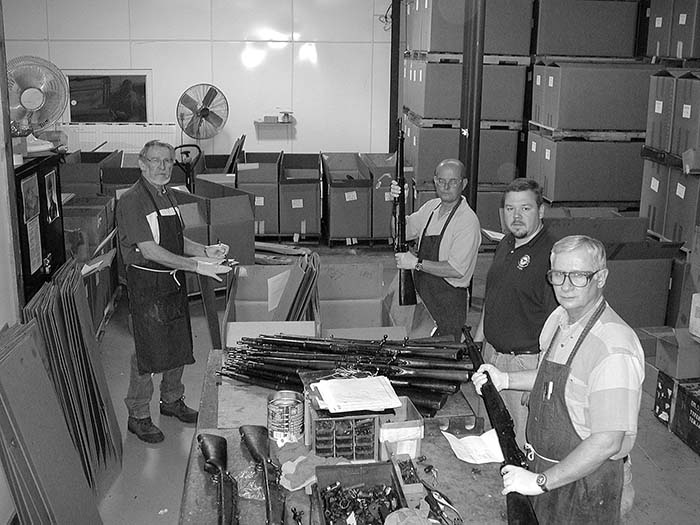
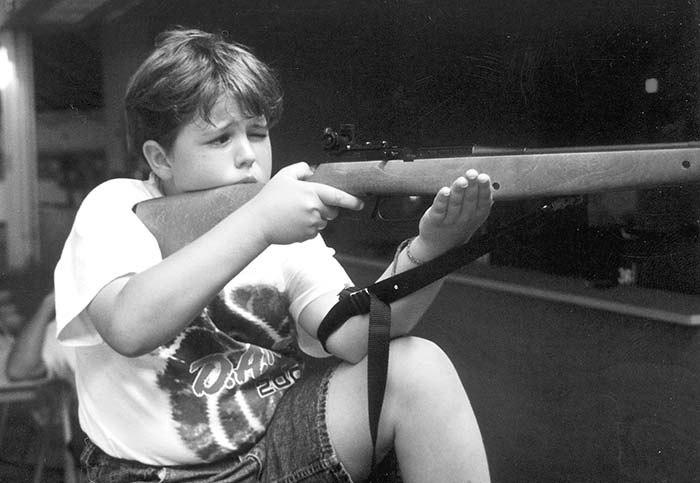
In 1996, Congress established the Corporation for the Promotion of Rifle Practice and Firearms Safety as a non-profit private corporation. The U.S. Army’s Director of Civilian Marksmanship (DCM) was replaced with the new Civilian Marksmanship Program (CMP) with the mission to instruct the citizens of the United States in marksmanship. The highest priority of this program is the training of junior shooters. The CMP program is offered through 1,500 affiliated clubs with adult membership of over 380,000 and junior membership of 68,000. These affiliates include traditional shooting clubs and state shooting associations, plus over 2,00 JROTC local school programs, 3,000 county extension agents (4-H) and over 300 Boy Scout Councils.
Through these sport shooting programs and dedicated volunteer coaches and instructors, thousands of young men and women are learning the skills and discipline of marksmanship as well as the responsibilities of gun ownership and citizenship. The enabling CMP legislation authorizes the sale of surplus .22 rimfire and .30-caliber rifles, ammunition, repair parts and supplies to members of affiliated clubs and organizations sponsoring shooting instructional programs. The proceeds from every purchase are used to support the operation of the CMP and build an endowment to fund youth programs in perpetuity.
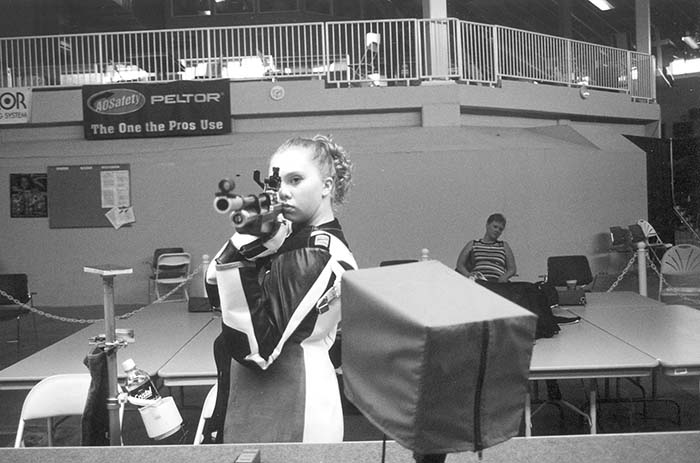
The Headquarters of the Civilian Marksmanship Program is located at Port Clinton, Ohio. This office is contiguous to the historic Camp Perry Firing ranges, which are still home of the CMP National Matches. The National Matches are conducted through a partnership of the CMP and the National Rifle Association. The U.S. Army Reserve and the Ohio National Guard provide support for the National Match Program. All support of the competitive rifle program, affiliated club services, sales of firearms, ammunition and parts and coordination of the junior and adult safety and marksmanship programs is based at Port Clinton. CMP at Anniston is the receiving and processing site for material, parts, ammunition and firearms drawn down from the U.S. Army. CMP at Anniston serves as the distribution center for processed orders from CMP Headquarters.
Recently I and several others traveled to Anniston, Alabama to the Anniston Army Depot to visit the Civilian Marksmanship Program. We were the guests of the Chairman of the Board of Directors of the CMP, Mr. Charles W. Maddox, and Mr. Orest Michaels, Chief Operating Officer for CMP.
We were first given an extensive a tour of the then-on-base facility for storage, processing, and shipping firearms and materials. Following our introduction to the CMP-South staff, we were allowed to examine the variety of firearms available to the membership as well as a substantial number of rare, and often one-of-a-kind, items that are auctioned on the CMP website, www.odcmp.com. We were also introduced to the armorers and watched them preparing M1s for sale. Many full-time staff are retired military and/or Civil Service. This staff is augmented by a limited volunteer program, which was suspended at the time of our visit because of 9-11 security constraints. Everyone we met was professional, knowledgeable, committed to their work and believes strongly in the mission of the CMP.
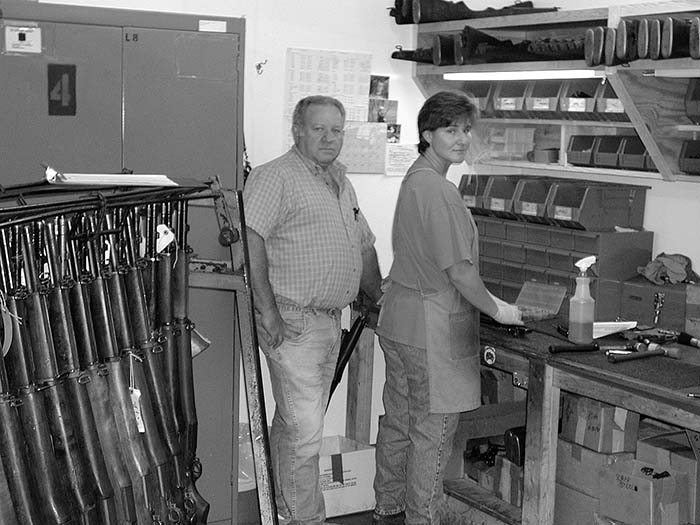
Mr. Maddox and Mr. Michaels briefed us on the history of the CMP and presented an exciting vision for the future of their programs. We learned that the on-base operations were being transferred to a new secure facility off base in the city of Anniston and that there were a ‘few’ 1903 and 03-A3 Springfield rifles that were being delivered and unloaded there. We were invited to visit the new warehouse and offices after lunch.
The new CMP-South office and warehouse facility was a modern, light industrial building in excellent condition. No work had been started to renovate the offices and the building was empty with one substantial exception. There were over 2,000 crates of 1903/03-A3 rifles being unloaded and stacked. In a small room, Michael J. Parker, from Oak Park, Virginia, was removing rifles in a random sampling of these containers and checking their manufacturer, serial number, barrel dates, stock type, and stock markings and cartouches. Parker’s objective was to survey the overall condition of the rifles to establish a range of values and how they could best be used in the CMP program.
All the 1903 rifles had been arsenal reworked and many appeared to be in very good to excellent condition considering their age and use. The rifles were low and high serial numbered Springfield and Rock Island arsenal rifles, post-World-War-I Springfield and Rock Island ‘03’s, Remington ‘03’s and Remington and Smith Corona 03-A3s. Stock types varied from early finger groove, pre and post-World-War-II C Stocks, ‘scant’ or S type semi-pistol grip stocks and Remington straight stocks. Barrel dates for the low numbered guns were as early as 1910. Many of the 03’s had been re-barreled with World-War-II Remington or Sedgley barrels. Most interesting were the large number of 1903 Mark I rifles with the left side of the receiver milled for the ejection port of the “Automatic Pistol .30 Model 1918,” also known as the Pederson device. We felt privileged watching history being pulled from these old crates. Here were the guns that served those who fought for freedom in World War I and World War II. Now, they were going to serve again, teaching generations to come of the sacrifices made for freedom in the past. The sheer number and variety of these guns made an unbelievable impression on each of us. We headed back home with the resolve to return and do some volunteer work at the first opportunity.
Volunteering to work with the CMP-South became possible in mid April. We found that the new CMP-South facility at 1401 Commerce Blvd. was fully operational and a beehive of activity. The transfer of the day-to-day operation from Anniston Army Depot had been completed. The armorers were busy inspecting and preparing .30 M1 Garands for shipment. Other full time staff was busy preparing firearms and ammunition for shipping. The warehouse operation was a fine example of military precision. Security was excellent and the material handling process showed that an experienced and very capable management team was in charge.
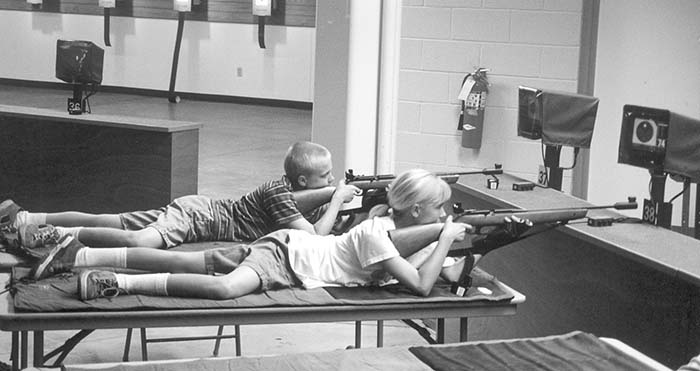
The original rifles we observed in October had been sorted by maker, low or high serial numbers, type of stock and model and placed in large boxes for further processing. Some of us were tasked to place correct straight handled bolts in low number 03 Springfield’s. The receivers of low number guns don’t meet safety standards because of some having improper heat-treating, and are sold as collectables only, with the tips of the firing pins ground off. We spent our time demilling firing pins, replacing bolts and checking the headspace with “field” and “go” gages. Others had the more desirable job of sorting post-World-War-I 03’s.
At the end of the second day, we had a chance to sit and talk shop with Mr.Orest Michaels and Joe Malinowski, Sales Representatives, and Mark Johnson, Business Development Officer. We learned that these ‘03’s represent the last known large stock of this service rifle. Their release to the CMP shows the confidence that the U.S. Army has in the program. The business-like approach that we observed in the CMP program did not just happen. The Board of Directors and the CMP staff are committed to make this program work successfully as a cost effective business.
How can an individual purchase a rifle from the CMP? You must be a member of an affiliated club, have a qualifying shooting certificate or have served in the military, and show proof of citizenship and qualifications to purchase and possess a firearm. “The Small Arms Review”, Vol. 5 No.9, has an excellent article on the John C. Garand Rifle Match, which will qualify a shooter for CMP purchase eligibility. Order forms can be obtained from the CMP at P.O. Box 576, Port Clinton, OH 43452, 419-635-2141 or at www.odcmp.com. The web site contains everything that you need to know purchasing a rifle. Every active shooting club should consider affiliation with the CMP to promote junior shooting programs and be eligible for member benefits.
The Civilian Marksmanship Program and its people are a strong voice for responsible private ownership of firearms in our country. The program and its volunteer instructors and coaches are recruiting and training thousands of young shooters each day. The CMP is one positive force working to preserve our right to firearms ownership and encourage the shooting sports. There is no stronger force for the future of firearms ownership and marksmanship than preserving our history and preparing young men and women to take our place as the responsible gun owners of the future.
| This article first appeared in Small Arms Review V6N5 (February 2003) |











